Dog tag
"Dog tag" is an informal but common term for a specific type of identification tag worn by military personnel. The tags' primary use is for the identification of casualties; as such, they have information about the personnel written on them, and convey essential basic medical information such as their blood type[1] and history of inoculations. They often indicate religious preference as well.
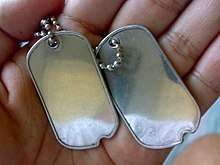
Dog tags are usually fabricated from a corrosion-resistant metal. They commonly contain two copies of the information, either in the form of a single tag that can be broken in half, or as two identical tags on the same chain. This purposeful duplication allows one tag, or half-tag, to be collected from a personnel's dead body for notification, while the duplicate remains with the corpse if the conditions of battle prevent it from being immediately recovered. The term arose and became popular because of the tags' resemblance to animal registration tags.
History
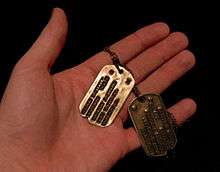
The earliest mention of an identification tag for soldiers comes in Polyaenus (Stratagems 1.17) where the Spartans wrote their names on sticks tied to their left wrists. A type of dog tag ("signaculum") was given to the Roman legionary at the moment of enrollment.[2] The legionary "signaculum" was a lead disk with a leather string, worn around the neck,[3] with the name of the recruit and the indication of the legion of which the recruit was part. This procedure, together with enrollment in the list of recruits, was made at the beginning of a four-month probatory period ("probatio"). The recruit got the military status only after the oath of allegiance ("sacramentum") at the end of "probatio", meaning that from a legal point of view the "signaculum" was given to a subject who was no longer a civilian, but not yet in the military.
In more recent times, dog tags were provided to Chinese soldiers as early as the mid-19th century. During the Taiping revolt (1851–66), both the Imperialists (i.e., the Chinese Imperial Army regular servicemen) and those Taiping rebels wearing a uniform wore a wooden dog tag at the belt, bearing the soldier's name, age, birthplace, unit, and date of enlistment.[4]
American Civil War
During the American Civil War from 1861–1865, some soldiers pinned paper notes[5] with their name and home address to the backs of their coats. Other soldiers stenciled identification on their knapsacks or scratched it in the soft lead backing of their army belt buckle.
Manufacturers of identification badges recognized a market and began advertising in periodicals. Their pins were usually shaped to suggest a branch of service, and engraved with the soldier's name and unit. Machine-stamped tags were also made of brass or lead with a hole and usually had (on one side) an eagle or shield, and such phrases as "War for the Union" or "Liberty, Union, and Equality". The other side had the soldier's name and unit, and sometimes a list of battles in which he had participated.[6]
Franco-Prussian War
On a volunteer basis Prussian soldiers had decided to wear identification tags in the Austro-Prussian War of 1866.[7] However, many rejected dog tags as a bad omen for their lives. So until eight months after the Battle of Königgrätz, with almost 8,900 Prussian casualties, only 429 of them could be identified. With the formation of the North German Confederation in 1867 Prussian military regulations became binding for the militaries of all North German member states. With the Prussian Instruktion über das Sanitätswesen der Armee im Felde (i.e., instruction on the medical corps organisation of the army afield) issued on 29 April 1869[8] the identification tags (then called Recognitionsmarke; literally "recognition mark") were obligatorily to be handed out to each soldier before marching afield. The Prussian Army issued identification tags for its troops at the beginning of the Franco-Prussian War in 1870. They were nicknamed Hundemarken (the German equivalent of "dog tags") and compared to a similar identification system instituted by the dog licence fee, adding tags to collars of those dogs whose owners paid the fee, in the Prussian capital city of Berlin at around the same time period.[9]
World War I

The British Army introduced identity discs in place of identity cards in 1907, in the form of aluminium discs, typically made at regimental depots using machines similar to those common at fun fairs, the details being pressed into the thin metal one letter at a time.
Army Order 287 of September 1916 required the British Army provide all soldiers with two official tags, both made of vulcanised asbestos fibre (which were more comfortable to wear in hot climates) carrying identical details, again impressed one character at a time. The first tag, an octagonal green disc, was attached to a long cord around the neck. The second tag, a circular red disc, was threaded on a 6-inch cord suspended from the first tag. The first tag was intended to remain on the body for future identification, while the second tag could be taken to record the death.[10][11]
British and Empire/Commonwealth forces (Australia, Canada, and New Zealand) were issued essentially identical identification discs of basic pattern during the Great War, Second World War and Korea, though official identity discs were frequently supplemented by private-purchase items such as identity bracelets, particularly favoured by sailors who rightly believed the official discs were unlikely to survive long immersion in water.[12]
The U.S. Army first authorized identification tags in War Department General Order No. 204, dated December 20, 1906, which essentially prescribes the Kennedy identification tag:[13]
An aluminum identification tag, the size of a silver half dollar and of suitable thickness, stamped with the name, rank, company, regiment, or corps of the wearer, will be worn by each officer and enlisted man of the Army whenever the field kit is worn, the tag to be suspended from the neck, underneath the clothing, by a cord or thong passed through a small hole in the tab. It is prescribed as a part of the uniform and when not worn as directed herein will be habitually kept in the possession of the owner. The tag will be issued by the Quartermaster's Department gratuitously to enlisted men and at cost price to officers.
The U.S. Army changed regulations on July 6, 1916, so that all soldiers were issued two tags: one to stay with the body and the other to go to the person in charge of the burial for record-keeping purposes. In 1918, the U.S. Army adopted and allotted the service number system, and name and service numbers were ordered stamped on the identification tags.
World War II "notched" tags
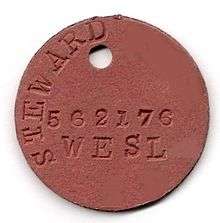
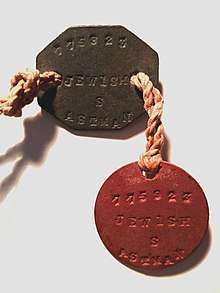
There is a recurring myth about the notch situated in one end of the dog tags issued to United States Army personnel during World War II, and up until the Vietnam War era. It was rumored that the notch's purpose was that, if a soldier found one of his comrades on the battlefield, he could take one tag to the commanding officer and stick the other between the teeth of the soldier to ensure that the tag would remain with the body and be identified.
In reality, the notch was used with the Model 70 Addressograph Hand Identification Imprinting Machine (a pistol-type imprinter used primarily by the Medical Department during World War II).[14][15] American dogtags of the 1930s through 1980s were produced using a Graphotype machine, in which characters are debossed into metal plates. Some tags are still debossed, using earlier equipment, and some are embossed (with raised letters) on computer-controlled equipment.
In the Graphotype process, commonly used commercially from the early 1900s through the 1980s, a debossing machine was used to stamp characters into metal plates; the plates could then be used to repetitively stamp such things as addresses onto paper in the same way that a typewriter functions, except that a single stroke of the printer could produce a block of text, rather than requiring each character to be printed individually. The debossing process creates durable, easily legible metal plates, well-suited for military identification tags, leading to adoption of the system by the American military. It was also realized that debossed tags can function the same way the original Graphotype plates do.
The Model 70 took advantage of this fact, and was intended to rapidly print all of the information from a soldier's dogtag directly onto medical and personnel forms, with a single squeeze of the trigger. However, this requires that the tag being inserted with the proper orientation (stamped characters facing down), and it was believed that battlefield stress could lead to errors. To force proper orientation of the tags, the tags are produced with a notch, and there is a locator tab inside the Model 70 which prevents the printer from operating if the tag is inserted with the notch in the wrong place (as it is if the tag is upside down).
This feature was not as useful in the field as had been hoped, however, due to adverse conditions such as weather, dirt and dust, water, etc. In addition, the Model 70 resembled a pistol, thus attracting the attention of snipers (who might assume that a man carrying a pistol was an officer). As a result, use of the Model 70 hand imprinter by field medics was rapidly abandoned (as were most of the Model 70s themselves), and eventually the specification that tags include the locator notch was removed from production orders. Existing stocks of tags were used until depleted, and in the 1960s it was not uncommon for a soldier to be issued one tag with the notch and one tag without. Notched tags are still in production, to satisfy the needs of hobbyists, film production, etc., while the Model 70 imprinter has become a rare collector's item.
It appears instructions that would confirm the notch's mythical use were issued at least unofficially by the Graves Registration Service during the Vietnam War to Army troops headed overseas.[16]
Dog tags are traditionally part of the makeshift battlefield memorials soldiers created for their fallen comrades. The casualty's rifle with bayonet affixed is stood vertically atop the empty boots, with the helmet over the rifle's stock. The dog tags hang from the rifle's handle or trigger guard.[17]
Non-military usage
Medical condition identification
Some tags (along with similar items such as MedicAlert bracelets) are used also by civilians to identify their wearers and specify them as having health problems that may
(a) suddenly incapacitate their wearers and render them incapable of providing treatment guidance (as in the cases of heart problems, epilepsy, diabetic coma, accident or major trauma) and/or
(b) interact adversely with medical treatments, especially standard or "first-line" ones (as in the case of an allergy to common medications) and/or
(c) provide in case of emergency ("ICE") contact information and/or
(d) state a religious, moral, or other objection to artificial resuscitation, if a first responder attempts to administer such treatment when the wearer is non-responsive and thus unable to warn against doing so. A DNR signed by a physician is still required in some states.
Military personnel in some jurisdictions may wear a supplementary medical information tag.
Fashion
Dog tags have found their way into youth fashion by way of military chic. Originally worn as a part of a military uniform by youth wishing to present a tough or militaristic image, dog tags have since seeped out into wider fashion circles. They may be inscribed with a person's details, their beliefs or tastes, a favorite quote, or may bear the name or logo of a band or performer.
Since the late 1990s, custom dog tags have been fashionable amongst musicians (particularly rappers), and as a marketing give-away item. Numerous companies offer customers the opportunity to create their own personalized dog tags with their own photos, logos, and text. Even high-end jewelers have featured gold and silver dog tags encrusted with diamonds and other jewels.
Variations by country
Austria
The Austrian Bundesheer used a single long, rectangular tag, with oval ends, stamped with blood group & Rh factor at the end, with ID number underneath.[18] Two slots and a hole stamped beneath the nunicew the tag to be broken in half, and the long bottom portion has both the ID number and a series of holes which allows the tag to be inserted into a dosimeter. This has been replaced with a more conventional, wider and rounded rectangle which can still be halved, but lacks the dosimeter reading holes.
Australia
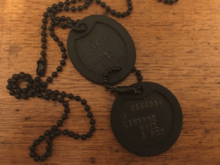
The Australian Defence Force issues soldiers two tags of different shapes, one octagonal and one circular, containing the following information:
- AS (denoting Australia, previously both AU and AUST have been used)
- PMKeyS/Service number
- First initial
- Last name
- Religious abbreviation (e.g. RC – Roman Catholic, NREL – No religion)
- Blood group
The information is printed exactly the same on both discs. In the event of a casualty, the circular tag is removed from the body.
Belgium
Belgian Forces identity tags are, like the Canadian and Norwegian, designed to be broken in two in case of fatality; the lower half is returned to Belgian Defence tail, while the upper half remains on the body. The tags contain the following information:
- Upper half:
- Belgisch Leger (Belgian Army) and Date of Birth in DD/MM/YYYY format.
- Surname with the addition of the first letter of given name.
- Service number and blood group with RH factor and optionally religion.
- Lower half: identical.
- Example:
- Belgisch Leger 01/01/1991
- Surname J
- 1234567 O+ KATH
Canada
Canadian Forces identity discs (abbreviated "I discs") are designed to be broken in two in the case of fatality; the lower half is returned to National Defence Headquarters with the member's personal documents, while the upper half remains on the body. The tags contain the following information:[19]
- Upper half:
- Service Number (SN)
- Initials and surname
- Religion (or "NRE" if none) and blood group with RH factor
- The legend "CDN FORCES CDN" (or for foreign nationals, the name of the country the individual represents)
- The text "DO NOT REMOVE / NE PAS ENLEVER" on the reverse
- Lower half: identical, except the reverse is blank.
Before the Service Number was introduced in the 1990s, military personnel were identified on the I discs (as well as other documents) by their Social Insurance Number.
China
The People's Liberation Army issues two long, rectangular tags. All information is stamped in Simplified Chinese:
- Full name
- Gender
- Date of birth
- RIC number
- PLA's ID number
- Blood type
- Branch
PLA is introducing a two-dimensional matrix code on the second tag, the matrix code contains a link to the official database. This allows the inquirer get more details about the military personnel.[20]
Colombia
The Ejército Nacional de Colombia uses long, rectangular metal tags with oval ends tags stamped with the following information:
- Family Name
- First Name
- Military ID Number
- Blood Type
- Branch of Service
Duplicate tags are issued. Often, tags are issued with a prayer inscribed on the reverse.
Cyprus
In Cyprus, identification tags include the following information:
- Surname
- First name
- Service number (E.g., 11111/00/00B, where the first five digits are the ID, the second two are the year the soldier turned 18 years old, the last two digits are the year the soldier enlisted, and the letter is the enlistment group, either A or B)
- Blood Group
Denmark
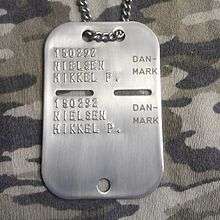
The military of Denmark use dog tags made from small, rectangular metal plates. The tag is designed to be broken into two pieces each with the following information stamped onto it:
- Personal identification number
- Surname
- First name
Additionally, the right hand side of each half-tag is engraved 'DANMARK', Danish for 'DENMARK'.[21] Starting in 1985, the individual's service number (which is the same as the social security number) is included on the tag. In case the individual dies, the lower half-tag is supposed to be collected, while the other will remain with the corpse. In the army, navy, and air force but not in the national guard, the individual's blood type is indicated on the lower half-tag only, since this information becomes irrelevant if the individual dies. In 2009, Danish dog tags were discontinued for conscripts.[22]
East Germany
The Nationale Volksarmee used a tag nearly identical to that used by both the Wehrmacht and the West German Bundeswehr. The oval aluminum tag was stamped "DDR" (Deutsche Demokratische Republik) above the personal ID number; this information was repeated on the bottom half, which was intended to be broken off in case of death. Oddly, the tag was not worn, but required to be kept in a plastic sleeve in the back of the WDA identity booklet.
Ecuador
The Placas de identificación de campaña consists of two long, rectangular steel or aluminum tags with rounded corners and a single hole punched in one end. It is suspended by a US-type ball chain, with a shorter chain for the second tag. The information on the tag is:
- Family Name & First Name
- Identification Number
- Blood Group, plus "RH" and "+" or "-"
Estonia
Estonian dog tags are designed to be broken in two. The dog tag is a metallic rounded rectangle suspended by a ball chain. Information consists of four fields:
- National identification number
- Nationality
- Blood Group
- Religion
Example:
- 39305231234
- EST
- A(II) Rh Pos (+)
- NO
Finland
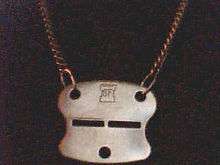
In the Finnish Defence Forces, "tunnuslevy" or WWII term "tuntolevy" (Finnish for "Identification plate") is made of stainless steel and designed to be broken in two; however, the only text on it is the personal identification number and the letters SF (rarely FI), which stands for Suomi Finland, within a tower stamped atop of the upper half.
France
France issues either a metallic rounded rectangle (army) or disk (navy), designed to be broken in half, bearing family name & first name above the ID number.
Germany
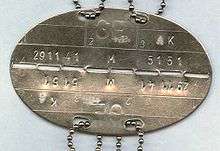
German Bundeswehr ID tags are an oval-shaped disc designed to be broken in half. They are made of stainless steel, 50.3 millimetres (1.98 in) heigh and 80 millimetres (3.1 in) width. The two sides contain different information which are mirrored upside-down on the lower half of the ID tag. They feature the following information on segmented and numbered fields:
On the front:
- Field 1: blank (provided for Gender but never used)
- Field 2: DEU (for Deutschland) (GE (for Germany) only on older ID tags)
- Field 3: Religious preference ("K" or "RK" for Roman Catholic, "E" or "EV" for Protestant, "O" for Christian Orthodox, "ISL" for Islamic, "JD" for Jewish, blank if no preference)
- Field 4: Personenkennziffer (service number: birth date in DDMMYY format, dash, capitalized first letter of last name, dash, and five-digit number based on soldier's home military administrative district, number of persons with the mentioned last name initial and same birthday, and an error-checking number but without dashes), ex. 101281-S-455(-)6(-)8
On the back:
- Field 5: Blood group (A, AB, B, 0)
- Field 6: Rh factor (Rh+ or Rh-)
- Field 7: Vaccination status ("T82" for Tetanus and year of basic immunization)
- Fields 8–10: blank
Greece
In Greece, identification tags include the following information:
- Surname
- First name
- Service number (where date of birth is included as "class")
- Blood Group
Hungary
The Hungarian army dog tag is made out of steel, forming a 25×35 mm tag designed to split diagonally. Both sides contain the same information: the soldier's personal identity code, blood group and the word HUNGARIA. Some may not have the blood group on them. These are only issued to soldiers who are serving outside of the country. If the soldier should die, one side is removed and kept for the army's official records, while the other side is left attached to the body.
Iraq
The Saddam-era Iraqi Army used a single, long, rectangular metal tag with oval ends, inscribed (usually by hand) with Name and Number or Unit, and occasionally Blood Type.
Israel
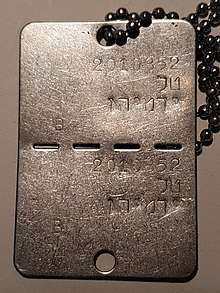
Dog tags of the Israel Defense Forces are designed to be broken in two. The information appears in three lines (twice):
- Army identification number ("mispar ishi", literally "personal number". A seven-digit number that is different from the nine-digit identification number for citizens).
- Last name
- First Name
- Blood Type (ABO group - in some years)
Recruits are issued with 2 Dogtags (4 halves total), one remains whole and worn on a necklace, and the second is broken into its halves and placed in each military boot for the purpose of Identifying dead soldiers (IDF Military Boots contain pouches on their inner sides at the 1/3 calf height, the pouches have holes corresponding in size and placement to those on the discs, allowing for fastening, often via small cable ties).
Originally the IDF issued two circular aluminum tags (1948 – late 1950s) stamped in three lines with serial number, family name, and first name. The tags were threaded together through a single hole onto a cord worn around the neck.[23]
Italy
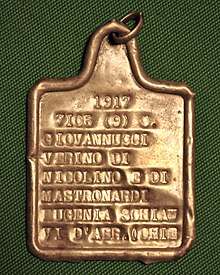
Rectangular piece, 35x45 mm, designed to be broken in two. Includes soldier's first and last name, coded date and place of birth, identification number, religious affiliation, and blood group.
Japan
Japan follows a similar system to the US Army for its Japan Self-Defense Forces personnel, and the appearance of the tags is similar, although laser etched. The exact information order is as follows.
- Japan Ground Self-Defense Force
- JAPAN GSDF
- First name, last name
- Identification number
- Blood type
- Japan Maritime Self-Defense Force
- First name, last name
- Identification number
- JAPAN MSDF
- Blood type
- Japan Air Self-Defense Force
- First name, last name
- Identification number
- JAPAN ASDF
- Blood type
Malaysia
Malaysian Armed Forces have two identical oval tags with this information:
- NRIC number (The last digit is an odd number for a male soldier, and an even number for a female soldier.)
- Service number
- Full name
- Blood type
- Religion
- Branch (e.g., TLDM)
If more information needed, another two oval wrist tags are provided. The term wrist tags can be used to refer to the bracelet-like wristwatch. The additional tags only need to be worn on the wrist, with the main tags still on the neck. All personnel are allowed to attach a small religious pendant or locket; this makes a quick identifiable reference for their funeral services.
Mexico
The Ejército Mexicano uses two long, very similar to the us army specification, rectangular metal tag with oval ends, embossed with Name, serial number, and blood type plus Rh factor.
Netherlands
Military of the Netherlands identity tags, like the Canadian and Norwegian ones, are designed to be broken in two in case of a fatality; the lower end is returned to Dutch Defence Headquarters, while the upper half remains on the body. There is a difference in the Army and Airforce service number and the Navy service number:
- Army number is made up of the date of birth in YY.MM.DD. format, for example 83.01.15, and a three-digit number, such as 123.
- Navy number is made up out of random five- or six-digit numbers.
The tags contain the following information:
- Upper half:
- Name and family name
- Service number
- Nationality (NL) and religion
- Blood group with RH factor
- Lower half: identical.
Norway
Norwegian dog tags are designed to be broken in two like the Canadian and the Dutch version:
- The top half contains the nationality, the eleven-digit birth number and the blood type.
- The bottom half contains the nationality and birth number and has a hole so the broken-off half can be hung on a ring.
Poland
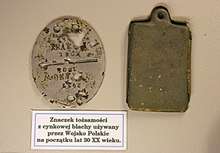
The first dog tags were issued in Poland following the order of the General Staff of December 12, 1920. The earliest design (dubbed kapala in Polish, more properly called "kapsel legitymacyjny" - meaning "identification cap") consisted of a tin-made 30×50 mm rectangular frame and a rectangular cap fitting into the frame. Soldiers' details were filled in a small ID card placed inside the frame, as well as on the inside of the frame itself. The dog tag was similar to the tags used by the Austro-Hungarian Army during World War I. In case the soldier died, the frame was left with his body, while the lid was returned to his unit together with a note on his death. The ID card was handed over to the chaplain or the rabbi.
In 1928, a new type of dog tag was proposed by gen. bryg. Stanisław Rouppert, Poland's representative at the International Red Cross. It was slightly modified and adopted in 1931 under the name of Nieśmiertelnik wz. 1931 (literally "Immortalizer mark 1931"). The new design consisted of an oval piece of metal (ideally steel, but in most cases aluminum alloy was used), roughly 40 by 50 millimeters. There were two notches on both sides of the tag, as well as two rectangular holes in the middle to allow for easier breaking of the tag in two halves. The halves contained the same set of data and were identical, except the upper half had two holes for a string or twine to go through. The data stamped on the dog tag from 2008 (wz. 2008) included:
- Name
- Surname
- ID number (PESEL- Universal Electronic System for Registration of the Population)
- "blank"
- Blood Group
with the name of Polish Army "Siły Zbrojne RP" and Polish Emblem.
Rhodesia
The former Republic of Rhodesia used two WW2 British-style compressed asbestos fiber tags, a No. 1 octagonal (grey) tag and a No. 2 circular (red) tag, stamped with identical information. The red tag was supposedly fireproof and the grey tag rotproof. The following information was stamped on the tags: Number, Name, Initials, & Religion; Blood Type was stamped on reverse. The air force and BSAP often stamped their service on the reverse side above the blood group.
Russian Federation
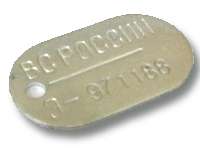
The Russian Armed Forces use oval metal tags, similar to the dog tags of the Soviet Army. Each tag contains the title 'ВС РОССИИ' (Russian for ''Armed Forces of Russia'') and the individual's alphanumeric number, as shown on the photo.
Singapore
The Singapore Armed Forces-issued dog tags are inscribed (not embossed) with up to four items:
- NRIC number
- Blood type
- Religion
- Drug allergies (if any; inscribed on the reverse)
The dog tags consist of two metal pieces, one oval with two holes and one round with one hole. A synthetic lanyard is threaded through both holes in the oval piece and tied around the wearer's neck. The round piece is tied to the main loop on a shorter loop.
South Africa
The South African Defense Force use two long, rectangular stainless steel tags with oval ends, stamped with serial number, name and initials, religion, and blood type.
South Korea
The South Korean Army issues two long, rectangular tags with oval ends, stamped (in Korean lettering). The tags are worn on the neck with a ball chain. The tags contain the information listed below:
- Branch (Army, Air Force, Navy, Marines)
- Service Number; the first two digits state the starting year of service and the other eight digits state the specific unit of the person.
- Name
- Blood group followed by Rh factor
South Vietnam
The South Vietnamese Army and the South Vietnamese Navy used two American-style dog tags. Some tags added religion on the back, e.g., Phật Giáo for Buddhist. They were stamped or inscribed with:
- Name
- SQ (Số Quân, i.e., Service number) a 2-digit year number, followed by a military serial number
- LM (loại máu, i.e., Blood Group, rH factor)
Soviet Union
During World War II, the Red Army did not issue metal dog tags to its troops. They were issued small ebony cylinders containing a slip of paper with a soldier's particulars written on it. These do not hold up as well as metal dog tags.[24] After World War II, the Soviet Army used oval metal tags, similar to today's dog tags of the Russian Armed forces. Each tag contains the title 'ВС СССР' (Russian for ''USSR Armed Forces'') and the individual's alphanumeric number.
Spain
Issues a single metal oval, worn vertically, stamped "ESPAÑA" above and below the 3-slot horizontal break line. It is stamped in 4 lines with:
- 1st line – Religion
- 2nd line – left side = blood group, right side = any medical allergies (SI or NO)
- 3rd line – military service (ET, EA ...)
- 4th (longest) line = DNI military number.
Sweden
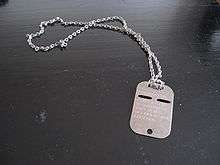
Swedish identification tags are designed to be able to break apart. The information on them was prior to 2010:
- Personal identity number (twice, once in the upper part and once below)
- Full name
- Residence at birth
- Blood type (only on some)
Swedish dog tags issued to Armed Forces personnel after 2010 are, for personal security reasons, only marked with a personal identity number.
During the Cold War, dog tags were issued to everyone, often soon after birth, since the threat of total war also meant the risk of severe civilian casualties. However, in 2010, the Government decided that the dog tags were not needed anymore.
Switzerland
Swiss Armed Forces ID tag is an oval shaped non reflective plaque, containing the following information:
- Social insurance number
- Surname
- First name
- Date of birth in DD.MM.YY format
On the back side the letters CH (standing for Confoederatio Helvetica) are engraved next to a Swiss cross.
United Kingdom
.jpg)
The British Armed Forces currently use two circular non-reflecting stainless steel tags, referred to as "ID Disks", engraved with the following 'Big 5' details:
- Blood group
- Service Number
- Last name (Surname)
- Initials
- Religion (Abbreviated, e.g; R.C - Roman Catholic)
The discs are suspended from one long chain (24 inches long) and one short chain (4.5 inches long)
During World War One and Two, service personnel were issued pressed fibre identity disks, one green octagonal shaped disc, and a red round disc (some army units issued a second red round disc to be attached to the service respirator). The identity disks were hand stamped with the surname, initials, service number and religion of the holder and if in the Royal Air Force, the initials RAF. The disks were worn around the neck on a 38" length of cotton cord, this was often replaced by the wearer with a leather bootlace. One tag was suspended below the main tag.
The fibre identity disks in the RAF were still in use in 1999.
From 1960 these were replaced with stainless steel ID tags on a green nylon cord, two circular and one oval. The oval was withdrawn around 1990.
United States
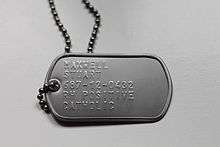
Tags are properly known as identification tags; the term "dog tags" has never been used in regulations.[25]
The U.S. Armed Forces typically carry two identical oval dog tags containing:
- U.S. Air Force (Format 1)
- Last name, first name, middle initial[26]
- Social Security number, followed by "AF" indicating branch of service[26]
- Blood Group[26]
- "blank"[26]
- Religion[26]
- U.S. Air Force (Format 2)
- Last name[26]
- First name and middle initial[26]
- Social Security number, followed by "AF" indicating branch of service[26]
- Blood Group[26]
- Religion[26]
- Last name[27]
- First and middle initials and suffix; blood group[27]
- Social Security number with three/two/four format as follows:123 45 6789[27]
- Branch ("USMC"); Gas mask size (S – small, M – medium, L – large)[27]
- Religious preference, or medical allergy if red medical tag[27]
- Last name, first name, middle initial
- Social Security number with no dashes or spaces followed immediately by "USN", space, blood group
- Religion
- Last name
- First name middle initial
- Dept of Defense ID number (replaced Social Security number in November 2015)[28][29]
- Blood type
- Religion
- Last name, first name, middle initial
- Social Security number, no dashes or spaces, followed immediately by branch (i.e., 123456789USCG)
- Blood group
- Religion
Religious designation
During World War II, an American dog tag could indicate only one of three religions through the inclusion of one letter: "P" for Protestant, "C" for Catholic, or "H" for Jewish (from the word, "Hebrew"), or (according to at least one source) "NO" to indicate no religious preference.[31] Army regulations (606-5) soon included X and Y in addition to P, C, and H: the X indicating any religion not included in the first three, and the Y indicating either no religion or a choice not to list religion.[32] By the time of the Vietnam War, some IDs spelled out the broad religious choices such as PROTESTANT and CATHOLIC, rather than using initials, and also began to show individual denominations such as "METHODIST" or "BAPTIST."[33] Tags did vary by service, however, such as the use of "CATH," not "CATHOLIC" on some Navy tags. For those with no religious affiliation and those who chose not to list an affiliation, either the space for religion was left blank or the words "NO PREFERENCE" or "NO RELIGIOUS PREF" (or the abbreviation "NO PREF") were included.[33]
Although American dog tags currently include the recipient's religion as a way of ensuring that religious needs will be met, some personnel have them reissued without religious affiliation listed—or keep two sets, one with the designation and one without—out of fear that identification as a member of a particular religion could increase the danger to their welfare or their lives if they fell into enemy hands. Some Jewish personnel avoided flying over German lines during WWII with ID tags that indicated their religion, and some Jewish personnel avoid the religious designation today out of concern that they could be captured by extremists who are anti-Semitic.[34] Additionally, when American troops were first sent to Saudi Arabia during the Gulf War there were allegations that some U.S. military authorities were pressuring Jewish military personnel to avoid listing their religions on their ID tags.[35]
See also
- Medical tattoo, also known as a meat tag
Notes
- "U.S. Soldiers "tagged" for blood transfusion". Popular Science. February 1942. p. 71, canned by Google Books.
- "Il Giuramento romano". Imperium Romanum. Retrieved March 25, 2016.
- Southern, Dixon (1996). The Late Roman Army. Batsford. pp. 74–75.
- Heath I., Perry M. The Taping rebellion 1851-66; Men-at-arm series 275; Osprey 1994
- McCormick, David (2012). Inventing Military Dog Tags.
- Maier, Larry B., 1949- (2008). Identification discs of Union soldiers in the Civil War : a complete classification guide and illustrated history. Stahl, Joseph W., 1946-. Jefferson, NC: McFarland & Co. ISBN 978-0-7864-3310-0. OCLC 475534981.CS1 maint: multiple names: authors list (link)
- Friedrich Loeffler, Das Preussische Militär-Sanitätswesen und seine Reform nach der Kriegserfahrung von 1866: 2 parts, Berlin: Hischwald, 1868 and 1869, pt. 1 'Die freiwillige Krankenpflege und die Genfer Convention vom 22. August 1864 nach der Kriegserfahrung von 1866', p. 63. No ISBN.
- Cf. Instruktion über das Sanitätswesen der Armee im Felde of 29 April 1869, Berlin: Mittler, 1869, article (§) 110. No ISBN.
- Law, Clive M. Article in Military Artifact, Service Publications
- "AO 287 - September 1916".
- "Identifying the Dead: a Short Study of the Identification Tags of 1914-1918".
- Catriona (11 November 2014). "Identity tags".
- Retired), Brigadier General Kennard R. Wiggins Jr (DE ANG (2015-09-07). Delaware in World War I. Arcadia Publishing. ISBN 9781625855091.
- "Notch Purpose on Army Dog Tags". Archived from the original on 2016-12-22. Retrieved 2009-12-22.
- Mikkelson, Barbara (2 August 2007). "Notch for the Faint Hearted". Snopes.com. Retrieved 12 September 2007.
- Col. David G. Fitz-Enz (Ret.): Why A Soldier? A Signal Corpsman's Tour from Vietnam to the Moscow Hotline, page 166. Ballantine, 2000. ISBN 0-8041-1938-4
- Auerbach, Paul S. (2011). Auerbach's Wilderness Medicine. Cushing, Tracy A.,, Harris, N. Stuart (7th ed.). Saunders. p. 593. ISBN 9780323396097. OCLC 962414488.
- "Usage of Dog Tags In Countries". Militarydogtag.com, Inc. Retrieved 2020-02-04.
- Canadian Forces Administrative Order 26-4 – Identity Discs Archived August 14, 2007, at the Wayback Machine Canadian Forces Finance & Corporate Services website
- http://mil.news.sina.com.cn/jssd/2017-02-24/doc-ifyavvsk2994974.shtml. Missing or empty
|title=(help) - "Dog Tags - ORGINALE DANSKE DOGTAGS".
- "Original Danish Dog Tags". armytags.dk (in Danish). Retrieved 27 October 2016.
- "Dog Tag History". Retrieved July 21, 2020.
- Ash, Lucy (January 14, 2014). "Digging for their lives: Russia's volunteer body hunters". BBC News Online. Retrieved May 31, 2015.
- Cucolo, Ginger. "Dog Tags: History, Stories & Folklore of Military Identification". The Library of Congress Webcasts. The Library of Congress. Retrieved 30 March 2016.
Never being called such in regulations, the “dog tag” has forever imprinted itself on the serving individual's mind and the tag they wear.
- "AFI 36-3103" (PDF). 18 May 2016.
- United States Marine Corps (14 July 2000). "MCO P1070.12K" (PDF). United States Department of the Navy. Archived from the original (PDF) on April 9, 2008. Retrieved 9 April 2008.
- http://www.apd.army.mil/epubs/DR_pubs/DR_a/pdf/web/p600_8_14.pdf
- Bushatz, Amy (8 December 2015). "In Major Change, Army Removes Social Security Numbers from Dog Tags". Military.com. Retrieved 8 December 2015.
U.S. Army dog tags will no longer include soldiers’ Social Security numbers, the Army announced on Tuesday, ending a more than 40-year identification system
- "Blitzkrieg Baby". Retrieved May 30, 2011.
- Non-commissioned officers guide, 4th edition, pg. 212.
- www.mooremilitaria.com, retrieved May 30, 2011 Archived June 26, 2011, at the Wayback Machine
- "In Harm's Way - Los Angeles". Retrieved May 30, 2011.
- "US Civic Political" (PDF). ajcarchives.org. pp. 178–179. Retrieved May 30, 2011.
External links
| Wikimedia Commons has media related to Dog tags (military identification). |
- "A Battlefield Souvenir?" – The Story of a Union Identity Disk in the Civil War´
- Captain Richard W. Wooley. "A Short History of Identification Tags". Quartermaster Professional Bulletin, December, 1988. Retrieved 12 September 2007.
- "Evaluation of the WWII German ID tag system" - Article on the weak points of WWII era German ID tags based on observations made during the recovery of missing soldiers.
- Newsreports showing WWII German soldiers being exhumed with their identification tags
- A guide for Reenactors and Collectors